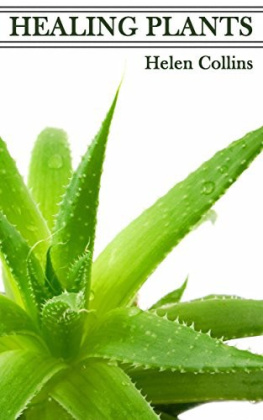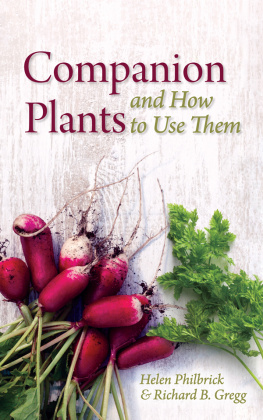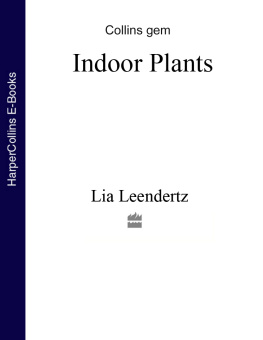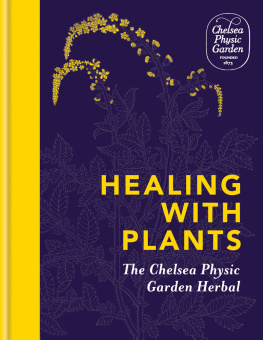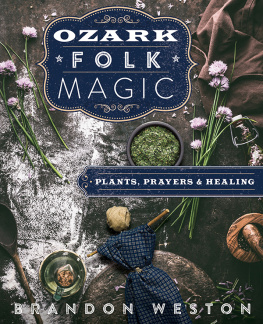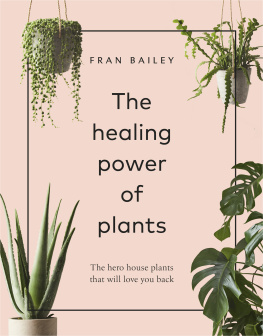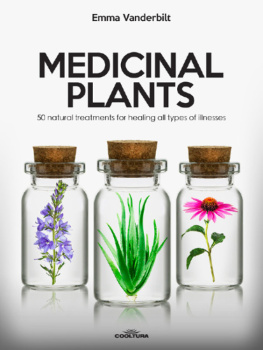Helen Collins - Healing Plants: An Introduction to the Healing Power of Plants
Here you can read online Helen Collins - Healing Plants: An Introduction to the Healing Power of Plants full text of the book (entire story) in english for free. Download pdf and epub, get meaning, cover and reviews about this ebook. year: 2014, genre: Religion. Description of the work, (preface) as well as reviews are available. Best literature library LitArk.com created for fans of good reading and offers a wide selection of genres:
Romance novel
Science fiction
Adventure
Detective
Science
History
Home and family
Prose
Art
Politics
Computer
Non-fiction
Religion
Business
Children
Humor
Choose a favorite category and find really read worthwhile books. Enjoy immersion in the world of imagination, feel the emotions of the characters or learn something new for yourself, make an fascinating discovery.
- Book:Healing Plants: An Introduction to the Healing Power of Plants
- Author:
- Genre:
- Year:2014
- Rating:5 / 5
- Favourites:Add to favourites
- Your mark:
- 100
- 1
- 2
- 3
- 4
- 5
Healing Plants: An Introduction to the Healing Power of Plants: summary, description and annotation
We offer to read an annotation, description, summary or preface (depends on what the author of the book "Healing Plants: An Introduction to the Healing Power of Plants" wrote himself). If you haven't found the necessary information about the book — write in the comments, we will try to find it.
Helen Collins: author's other books
Who wrote Healing Plants: An Introduction to the Healing Power of Plants? Find out the surname, the name of the author of the book and a list of all author's works by series.
Healing Plants: An Introduction to the Healing Power of Plants — read online for free the complete book (whole text) full work
Below is the text of the book, divided by pages. System saving the place of the last page read, allows you to conveniently read the book "Healing Plants: An Introduction to the Healing Power of Plants" online for free, without having to search again every time where you left off. Put a bookmark, and you can go to the page where you finished reading at any time.
Font size:
Interval:
Bookmark:
Healing Plants
An Introduction to the healing power of plants
All rights reserved. No part of this publication may be reproduced or transmitted in any form or by any means, electronic or mechanical, including photocopy, recording, or any information storage and retrieval system, without permission in writing from the publisher.
Contents
In this book, we are going to take a look at what plants and herbs can do for us, to improve our health and our general wellbeing, including how to make various cosmetics using plants and herbs. We will learn how flowers can be used in meditations, how the use of colour affects us all, and how we can use fresh and dried flowers as decorations and for healing.
For centuries people have been aware that plants and flowers can be used in a healing capacity. Herbalism and homoeopathy, for example, are just two fields of therapy which use the inherent properties of plants and flowers to benefit health. Aromatherapy is another holistic therapy which seeks to reduce stress, illness and disease using the power of oils obtained from plants and flowers. The use of the power of flowers in healing is nothing new: the ancient Greeks used specific fragrances as healers, such as white violet for curing stomach upsets. Before the benefits of aromatherapy became widely known as an aid to relieving stress, scented bath cubes or various colognes or rosewaters were added to bathwater, not only to make the skin smell nice, but also to help the relaxation process.
Many people are now turning to the power of aroma therapy oils to achieve physical benefits and to address many psychological conditions which are now, sadly, commonplace in our lives. The Bach Flower Remedies (Bach is pronounced batch) help to heal us mentally and physically, so we will also take a look at these, and at the linking of oils and colours in Aura-Soma. We will discover the benefits of natural products over artificial substitutes.
If we can understand and appreciate what is around us in the world of flowers, perhaps we might be encouraged to protect flowers and plants for future generations. Many people are now actively engaged in fighting the development of urban areas in areas of outstanding natural beauty, and while not wishing to debate the rights and wrongs of what humankind seems to be doing to our planet, I believe that if we all understand a little more about nature, we will not seek to destroy so much of it so readily. Let's begin our journey of discovery, therefore, and take a more detailed look at the power of flowers.
Flowers, and also whole plants, barks, roots and herbs, have traditionally been used for a variety of things - not only for decorative purposes and gifts, but also in medicine, as fragrances, in skin and beauty preparations, and as food or decoration for food. In history, we used flowers and plants a little more in health care than is the case today, partly because many of the plants and (lowers held to be useful medically in the past may no longer have therapeutic value, due to interventions by medical science and technology. There are many plants, however, whose usage remains important. Mistletoe, for example, is known to be effective in treating high blood pressure and migraine, because it contains the drug guipsine. It has also been used effectively in the treatment of arteriosclerosis, and its Celtic name uile translates as 'all-healer'. Those suffering from dandruff might also like to try it in shampoo form, as it certainly works!
In this chapter, we will look at how our ancestors used (lowers, plants, herbs, shrubs and barks, for a variety of everyday uses, including medicine and beauty preparations. We will also consider the plants and flowers mentioned in the Bible - the word 'paradise' is derived from the Persian word for a walled garden!
Beauty and Healthcare
When you were a child at school, I am sure that one of the first topics you studied in History was the growth of and development of the human race. I remember learning about Troglodytes (cave dwellers) and visiting a museum where there was a 'mock-up' cave, complete with inhabitants, then subsequently going on a nature ramble with a teacher to look at the types of berries and plants that these cave dwellers probably used in their daily lives. I learnt, for example, that chewing on the leaves of a willow would cure a headache. This was a folk remedy from ancient times, which worked because the leaves of the willow contain a small portion of salicylic acid, which is a component of aspirin. It didn't taste too good, but it worked!
Beauty preparations
At school we also learnt a little about how other generations used various flowers and plants for beauty care. I remember vividly, when I was probably only about 8 years old, collecting what seemed at the time to be tonnes of rose petals to make some rosewater to use in the bath. Rosewater is useful in skincare preparations because it helps to soothe the skin and is a mild astringent. It is, incidentally, often used in commercial skincare preparations as a toner for those with dry skins. In the seventeenth century in Britain, women used rhubarb juice and white wine as a lightener for their hair and also used a mixture of burnt rosemary and alum flowers for cleaning their teeth - gruesome! Civilisations in the distant past used plants and flowers to help to improve their appearance, both by face painting and by using flowers as decorations, and also used flower oils as fragrance.
We still use flowers and their properties in skincare and beauty preparations. Many readers will be familiar with henna in shampoos and hair care preparations. Henna, particularly important in Muslim countries, is an evergreen shrub that has fragrant clusters of small cream coloured, four-petal flowers at the tips of each branch, and henna seeds have long been used to tint and dye the hair, finger and toe nails, fingertips, hands, feet, beards and even the manes, hoofs and tails of horses, as well as skins and leather. Many ancient Egyptian mummies appear to have been wrapped in cloth dyed with henna. Also, it is mentioned in the Bible in the Song of Solomon, and for many centuries, especially in the Middle East, henna's strong fragrance has been popular. Many Eastern races use henna in bouquets, and women wear it in their hair and put it on their clothing. Other natural hair and body dyes and tints can be obtained from camomile, marigold flowers, saffron roots or flowers, turmeric, rhubarb (also a good laxative) and sage (good to use in the bath), but more of that later.
Saffron is also mentioned in the Bible in the Song of Solomon. An Old World crocus, it takes about 4,000 blooms to make just 28 grams (1 oz) of saffron, using the dried styles and stigmas of the flowers. Consequently, saffron is quite expensive to use, but makes a lovely herbal tea beneficial in treating skin or liver problems, and is a good flavouring for foods. It was also formerly used as a perfume. Another flower mentioned in the Bible is the lily, which Jesus mentions in the Gospels according to Matthew and Luke. In Biblical terms, the lily and beauty were interchangeable. The marshmallow plant, closely related to the hollyhock, is mentioned in the Bible in Job as being used as food in times of hardship. Its tastelessness was obviously a strong point in its favour, as many other plants were known to have a bitter taste. Nowadays used as an ingredient of facepacks, it can also be used in the form of a tea for treating digestive problems, especially in children.
The ancient Greeks used a great number of plants for health benefits. Plants were used in drinks, and a trip to any health store or supermarket will reveal many plant-based teas now available.
Font size:
Interval:
Bookmark:
Similar books «Healing Plants: An Introduction to the Healing Power of Plants»
Look at similar books to Healing Plants: An Introduction to the Healing Power of Plants. We have selected literature similar in name and meaning in the hope of providing readers with more options to find new, interesting, not yet read works.
Discussion, reviews of the book Healing Plants: An Introduction to the Healing Power of Plants and just readers' own opinions. Leave your comments, write what you think about the work, its meaning or the main characters. Specify what exactly you liked and what you didn't like, and why you think so.

